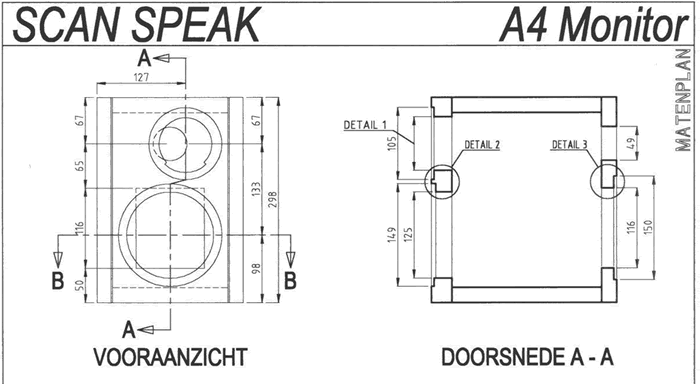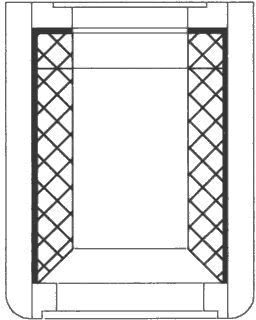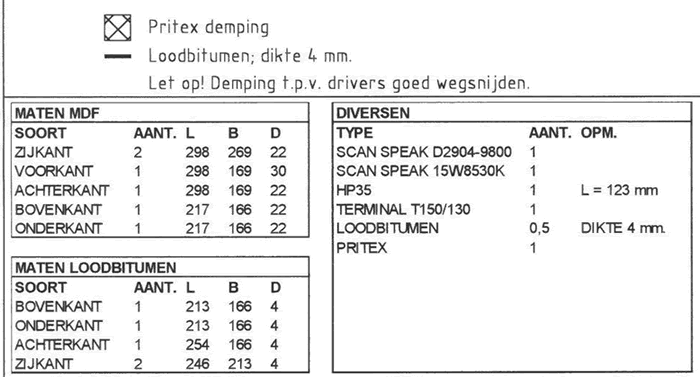First, design and production <br> due to the ordinary family room. The interior space is not spacious enough, and the speakers are required to be as small as possible, and not placed in the room for attention. However, the efficiency of the speaker no has the following relationship with the box volume VB and the low frequency -3d8 roll-off point f3:
No=kn·f33·VB
In the above formula, kn is the box coefficient, kn=2x10-6 for well-designed bass reflex speakers, and kn=10-6 for high-quality closed speakers. The unit of the tank volume VB is l (liter), and the unit of f3 is Hz (h). Therefore, if you want to reduce the volume of the box, you must increase the -3dB low-frequency roll-off frequency to make the low-frequency response worse, otherwise you have to allow the speaker to work at a lower frequency. Today's high-power amplifiers generally have sufficient power margin, and it is no longer a problem to drive low-frequency speakers. Therefore, some well-designed small speakers may have wider bandwidth and better low-frequency response. Of course, the volume of the cabinet cannot be reduced indefinitely so as not to exceed the power limit of the speaker and burn out the voice coil or increase the nonlinear distortion of the speaker.
The designers of this speaker have successfully designed the right balance between the small-volume cabinet and the excellent sound quality, which are mutually incompatible. The tuning of the bass reflex and the crossover filter are calculated very correctly, and the solid case has no resonance. Of course, the use of Scan-Speak's high-end drive unit is also an important factor in the success of this speaker. After listening, the sound quality of this speaker is very close to that of a much larger speaker, so many auditors (they can't see the speaker) think they are listening to the larger speakers.
This article refers to the address: http://
1. The era of scorn and ridicule in the two-way speaker system with two-way mode is gone forever. The four-way or five-way system has been gradually reduced after a short-lived system. Many high-end speaker manufacturers have returned to two-way or Three-way system. However, the audio industry has faced a problem for many years, which is better than the two-way and three-way system. The designer of this speaker believes that the correct answer to this question can only be found when all the conditions are known. Even at this point, remember that any multi-channel system is the result of compromise. The ideal solution is to use only one drive unit for the speaker, which provides a straight phase and frequency response for the entire audio range of 20Hz-20kHz. Since there is no such ideal full-range drive unit, it is a last resort to use two or three drive units to reproduce the sound of the audio range. At the crossover point of these units, there are inevitably some errors that are difficult to eliminate and remedy, which is why most speaker manufacturers limit the number of crossover points (ie, limit the number of drive units).
The choice of the multi-channel system drive unit depends on the sound pressure required for playback. For example, if the bass is required to have a high sound pressure level (SPL), a woofer with a diameter of 25 cm or more is required. Unfortunately, this large-caliber drive unit has a tendency to have a low-frequency response ridge, which is not suitable for frequencies above 1 kHz, and is not suitable for two-way systems because the current tweeter cannot cover the 1 kHz-20 kHz frequency range. The 28mm dome tweeter usually cannot reproduce 2kH2 - 3kHz sound, and the low end limit frequency of the 19mm dome tweeter is as high as 4kHz-51kHz. Their low-end frequency response and the high-end frequency response of large-diameter woofers do not achieve a smooth transition.
If the sound pressure level of the bass range is allowed to be less than 100 dB, a woofer with a smaller aperture can be used. At such low sound pressure levels, it is often difficult to make the low frequency response dive below 50 Hz, but the Scan-Speakl 5 cm low/midrange unit used in this speaker can generate enough sound output at low frequencies and can reproduce satisfactorily. 2kHz-3kHz sound, so you don't have to use the midrange unit. Some of the smaller woofers are designed to reproduce the bass very satisfactorily in smaller speakers, and the low/midrange unit used in this speaker is a good example.
2. Selection of the drive unit The drive unit of this speaker is selected from the Scan-Speak company of Denmark (see Figure 2). The company was originally an independent manufacturer and was acquired by Vifa a few years ago to become Vifa's high-end product division. Scan-Speak's drive units are mostly hand-made high-quality cone and dome products. The D2905/990000 Revelator tweeters, which were introduced in the 1980s, have been highly prized around the world. The honor is considered to be the best dome tweeter on the market.
The 15w 8530K00 15cm low/midrange unit used in this speaker is also part of the “Revelator†series, which is designed to fit a special long-stroke voice coil and facilitate airflow. Thanks to the absence of resonance, the enhanced cone has excellent damping and the cone of the cone has good linearity, the unit offers the most realistic playback and dynamic performance in its class.
Until now, Scan-Speak's tweeters are all made of fabric domes. Only the D2904/980000 28mm tweeters used in this speaker are the company's latest aluminum domes. The sound pressure frequency response of any dome has a series of valley points (zero points). The path difference between the arrival of the sound wave reaching the top of the dome and the edge is exactly the frequency at which the sound wave travels in the air by a factor of two. As a result, a phase difference is generated near these zero points, causing the axial acoustic output to gradually decrease toward zero.
The frequency fn at which the zero point appears is a function of the dome height h. 28mm aluminum ball top h=5mm, so
Fn=C/in=345/5×(10)-3=69kHz
Therefore, the first valley point appears at 34.5 kHz. When the dome unit is driven by a voice coil of the same diameter mounted on the edge, the first split resonance occurs near the first phase zero (34.5 kHz in this example), which is much higher than human hearing. range. The tweeter has a lower resonant frequency (500 Hz), which linearizes the sound by a separately suspended special diffuser when replaying the highest frequency. Its sound is very open, clear and detailed.
3. Crossover filter The passive crossover filter of this speaker provides the corresponding high and low frequency bands for the two drive units. It is carefully designed to match the characteristics of the drive unit with the cabinet. Do not change the filter easily during production. Circuit and drive unit.
The circuit of the crossover filter is shown in Figure 3. The first-order low-pass filtering portion of the low/midrange unit is mainly composed of the inductor L1 and the capacitor C1, and its frequency response roll-off rate is 6 dB per octave. The network R1-C1 compensates for the increase in impedance of the unit (LS1) at high frequencies, and does not function properly without its filter. In order to minimize the internal resistance of L1, the inductor is twisted into a 1.5-inch Tritec stranded wire with a diameter of 0.5 mm to form a disk-shaped hollow core inductor with an inductance of 2.2 mH. The resistance is 0.52 ohms. Another advantage of using stranded wires is that the skin effect is small.
The third-order high-pass filtering portion of the tweeter consists of C2, C3, and L2, and its frequency response roll-off rate is 18 dB per octave. Since the sensitivity of the two units is different, the voltage dividers R1-R3 attenuate the power applied to the tweeter LS2 by 5 dB in order to keep the acoustic outputs of the two units consistent. C2 and C3 have a large impact on the performance of the speaker and must be handled by high quality capacitors, at least with metallized polypropylene (MKP) capacitors. According to the designer, C2 is preferably composed of a 1pF in parallel with a 4.7pF tin foil (KPSn) capacitor, and C3 consists of two parallel 10uF MKP capacitors in series with a 47uF KPSn capacitor. However, at the time of audition, the difference was heard between the sample containing the MKP capacitor and the sample containing the KPSn capacitor.
The crossover frequency of the entire filter is designed at 2 kHz, and the main purpose is to achieve a seamless transition between low/intermediate frequency response and high frequency response. From the frequency response characteristic curve shown in Figure 4, the frequency division point is not detected, indicating that the design of the frequency divider filter of this speaker is successful. Due to the small number of components, the crossover filter can be mounted on a self-made or commercially available crossover filter printed circuit board, as shown in Figure 5. The disc coil on the left side of the figure is the hollow core inductor L1 wound with a twisted wire. Note that the two drive units LSl and LS2 must be connected in phase according to the polarity shown in Figure 3, otherwise the performance of the speaker will be seriously degraded.
4, the box making This speaker's cabinet is relatively simple to make, just press as shown in Figure 6. Six boxes with corresponding openings can be fastened together without the use of stiffeners or struts. The tweeter is mounted at a position offset from the center of the panel and rounded on both sides of the front panel in order to obtain the correct direction of radiation. In addition, the bass reflex port is located not on the front panel but behind the cabinet as compared to the usual practice. The sound tube connected to the reflection port can be made of a polyvinyl chloride plastic tube with a diameter of 35 mm and a length of 123 mm.
In order to avoid the resonance of the box, a 22mm thick medium density fiberboard (MDF) is used for the side panel and the upper and lower panels, and a 30mm thick MDF is used for the front panel. Preferably, the inner surfaces of the six box panels are all coated with 4 mm thick lead (but more expensive), or the same thickness of asphalt felt can be applied for acoustic damping. The damping material should be carefully cut off at the opening of the box to avoid obstructing the installation of the drive unit and the sound tube.
As shown in Figure 6, the two drive units should be flush mounted on the front panel, otherwise there will be several valley points in the frequency response. The speaker panel on the rear panel also uses the same mounting method, but the latter is only for aesthetics. The patch panel has two large terminals that are connected to the speaker cable. If a bi-wir-ing connection is desired, a speaker patch panel with four posts can be used. The crossover filter circuit board is mounted on the inner bottom of the box, and is connected to the drive unit and the speaker terminal with a high quality speaker cable. The outer surface of the box can be painted or veneered according to each person's preference.
Second, the measured results <br> In order to truly and comprehensively understand the performance of this speaker, the first test, first test, then instrument test, and finally carefully audition. The results show that the instrument test and audition results are very consistent, everything is expected, the actual audition is better than the instrument test results.
The frequency characteristics of this speaker are shown in Figure 4. The overall flat response and a slight emphasis near 100 Hz are not repeated. The frequency response around 500 Hz has a small amount of subsidence, and there is a 1.5 dB slight bulge near 750 Hz, which does not impair the actual performance. They are certainly not caused by the low/midrange unit because the frequency response of the unit is as straight as a pencil. In fact, they are caused by the small size of the front panel, which is similar in most small speakers. The curve indicated by the dashed line in Fig. 4 is the low frequency response directly measured in front of the bass reflex port. The reflection port is tuned to 40 Hz, and the impedance characteristics of Figure 7 more clearly indicate this. The figure also shows that the impedance of this speaker is not less than 7 ohms, which means that any suitable amplifier can drive it. However, it is best to use a power amplifier with a large power reserve because the sensitivity of this speaker is low (about 85. 5dB/W from lm).
Third, audition evaluation <br> Instrument test is important, but the performance of the speaker can only be made through careful audition to make a final evaluation. Although the speaker is small in size and not surprising, it produces a very open and realistic sound that is better for replaying good live recordings. Its sound details replayed in the midrange and treble range are reminiscent of electrostatic speakers. The bass is tight, unrendered and the depth of the dive is unexpected. The low-frequency 3-dB point is around 40Hz.
As people expect from quality monitors, this speaker is not biased towards any kind of music, it reproduces classical music, jazz and popular music are equally perfect, round and natural. Replaying the distinctive songs of Pavarotti, Reed, Fitzgerald and Brightman is as true as the sound of Perlman's violin, Goodman's clarinet and Williams' guitar. . In short, this speaker is one of the few speakers that makes you forget to listen and fully immerse yourself in music.
However, it must be remembered that even small speakers with such good performance have some limitations in their low frequency performance. However, the low frequency limitation of this speaker is not outstanding, but it becomes obvious when compared directly with large speakers. At this point, you need to use a large speaker that is 10 times larger than the speaker to show the difference in low-frequency performance.
Since the bass reflex port is located behind the cabinet, this speaker should not be placed directly facing the wall. But when you listen to it, it is better to put it near the wall than to stay away from the wall. At this time, the bass is extraordinarily warm, and when it is far away from the wall, the sound is cooler.
 Javascript:resizepic(this) border=0>
Javascript:resizepic(this) border=0>  Javascript:resizepic(this) border=0>
Javascript:resizepic(this) border=0>  Javascript:resizepic(this) border=0>
Javascript:resizepic(this) border=0>  Javascript:resizepic(this) border=0>
Javascript:resizepic(this) border=0>  Javascript:resizepic(this) border=0>
Javascript:resizepic(this) border=0>  Javascript:resizepic(this) border=0>
Javascript:resizepic(this) border=0>  Javascript:resizepic(this) border=0>
Javascript:resizepic(this) border=0>
4 years of manufacturing experience. High cooler rendering index luminous efficiency with soft light output. PC shade high transmittance, weather resistance high cooler rendering inde luminous. Efficiency with soft light output. Low power consumption.Lower heating during operation. Lumen decay: 3 within 1000 hours. Then Lumens be stable. Low power consumption.Lower heating during operation.Lumen decay: 3 within 1000 hours. Then Lumens be stable. No mercury, enviromental protection. The shell of Led Downlights adopt integrated design, it optimize efficiency of heat dissipation.
*Related Products:exterior downlights,Dimmable LED Downlight,light fittings,detachable led,led recessed light,adjustable downlight.
Led Downlights,Dimmable Downlight,Smd Downlights
SHENZHEN KEHEI LIGHTING TECHNOLOGY CO.LTD , http://www.keheiled.com